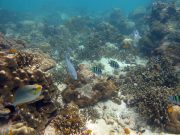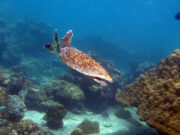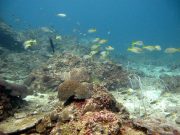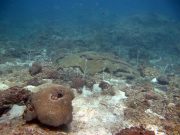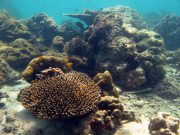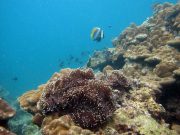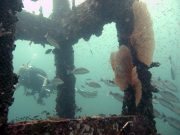Diving Koh Phi Phi
Mu Ko Phi Phi National Park
The Phi Phi islands are an archipelago of six islands just a 35 minute speed boat ride from Lanta. The two largest islands are Phi Phi Don and Phi Phi Leh, with the best diving around Koh Phi Phi Leh.
The islands are characterised by stunning, sheer limestone cliffs topped with untouched tropical jungle, breathtaking turquoise lagoons and a spectacular underwater world.
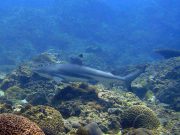
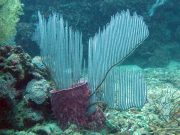

Many of the best dive sites and marine life can be found around Koh Phi Phi Leh and the Bida islands, with overhangs, swim-throughs, canyons and gorges, huge Gorgonian Sea Fans, amazing colourful soft corals, hard corals and anemones.
The dive sites are also great for student divers and scuba courses, including introduction dives, check dives and refreshers, the open water course and the advanced course.
Phi Phi Leh is famous for its dramatic limestone cliffs, hidden lagoons, and stunning beaches, and whilst Maya Bay attracts many tourists for its breathtaking scenery, the true magic of Phi Phi Leh lies underwater on its coral reefs.
Koh Phi Phi Palong
Diving Koh Phi Phi Palong from Koh Lanta
Palong Bay is located just north of Maya Bay on the west side of Phi Phi Leh, with two distinct dive sites with the bay at the centre.
The first dive site to the north of Palong Bay features an extensive shallow plateau where we can often see black tip reef sharks cruising the reef.
The second dive site is to the south of Palong Bay, heading towards Maya Bay. Half-way along this reef is a series of excellent swim-throughs and small tunnels on the rock formations, however we mostly visit Palong South to dive with the hawksbill turtles which can be regularly seen on our dives here.
Palong Marine Life
One of the most compelling reasons to dive at Palong Wall is the diversity and abundance of marine life. The site is home to a rich ecosystem, with species ranging from the smallest critters to larger pelagics.
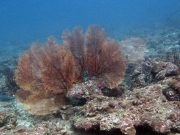
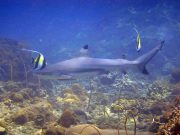
We love diving around Koh Phi Phi, particularly at Palong, because of the diversity of marine life found at these dive sites.
Find out more from the Thailand Department of National Parks on the Mu Koh Phi Phi Marine National Park.
Coral Reef
The long rocky reef slopes at Palong Wall are covered in thousands of coral colonies, including honeycomb corals, brain corals, bubble corals, gorgonian sea fans, whip corals, barrel sponges, and anemones.
These corals, sponges and anemones are home to millions of colourful reef fish, with many large rocky coral outcrops supporting huge populations of glassfish - transparent juvenile fish of varying species.
The hard coral formations and huge soft coral fans form a huge sprawling reef along the west side of Phi Phi Leh.
Fish Species
A wonderful variety and diversity of reef fish can be found at Palong, including many species that we don’t often see elsewhere.
Of course, we also have the usual reef dwellers, including surgeonfish, pufferfish, filefish, parrotfish, emperors, grouper, wrasse, damselfish, cornetfish, snapper and fusiliers.
Occasionally lone barracuda can be seen lurking along the reef, searching for prey, and along the reef edge we can spot razorfish, blue triggerfish and highfin butterflyfish, which are not normally spotted at Bida or Koh Haa.
Macro life
Macro photographers will love diving at Palong wall, where we can find a large variety of life, nudibranches, including Blue Dragons, wart slugs, ghost pipefish, seahorses, cleaner shrimp, and Janss Pipefish hiding under rocky ledges.
If you have a torch then bring it along to help spot the shy creatures hiding in coral crevices or under rocky ledges.
Other Marine Life
Palong is well known for its local population of hawksbill turtles, which are often seen grazing on bubble corals or swimming along the top of the reef edge. Cuttlefish and occasionally octopus can be found camouflaged among the corals.
Blacktip reef sharks can also be seen cruising along shallows to the north of Palong Bay, or deeper out in the rocky plateaus and sandy flats, where we can also spot reef squid and blue spotted stingrays.
Exploring Phi Phi Palong
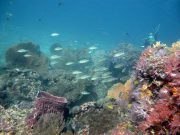
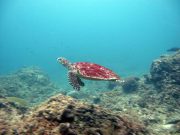
Palong North
This dive site begins with a wide shallow plateau just north of Palong Bay. The plateau starts around 5 m and very gently spreads down to around 10 m, then sloping more steeply down to 16 - 17 m.
Palong North is well known for the schools of blacktip reef sharks which are frequently spotted. These sleek and graceful predators are often seen cruising along the wall or in the shallower areas near the reef.
Whilst shark sightings are not guaranteed, these sharks are very common in the area and are relatively accustomed to the presence of divers.
There’s also a chance to spot hawksbill turtles, or possible small schools of razorfish, which can be found sheltering close to soft coral formations between the rocky pinnacles and valleys.
Heading further north, the plateau slowly transitions to a rocky slope, eventually becoming quite steep in places, and more exposed to the currents sweeping the north west of Phi Phi Leh.
Palong South
The Palong South dive site connects Palong Bay to the entrance of Maya Bay, and is one of the best places to spot hawksbill turtles around Phi Phi. It’s unusual for us to dive there without spotting at least one or two turtles, sometimes more.
A shallow plateau can be found at 5m which is great for beginner level divers. The plateau extends to become a gentle rocky slope down to 12 - 17 metres, covered with both hard and soft corals, anemones, and barrel sponges.
The rocky slope features several swim-throughs, and the sandy bottom has scattered coral bommies, huge mushrooms, with a chance to spot leopard sharks or stingrays resting in the sand.
It’s not uncommon to see cephalopods during this dive, including octopus, cuttlefish and reef squid.
Phi Phi - Palong Dive Site Guide
- NamePhi Phi Palong
- Visibility5m - 20m +
- Level of DivingAll Levels
- SnorkelingNo
- Depth3m - 18m +
- CurrentsMild to Medium
- Journey Time35 - 45 mins
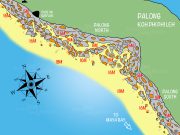
Book online to save 10% on dive trips and scuba courses on Koh Lanta.
Phi Phi Viking Bay & Artificial Reef
Diving Phi Phi Viking Bay from Koh Lanta
Viking Bay and Artificial Reef are located on the northeastern side of Phi Phi Leh.
Viking Bay is named after the nearby Viking Cave, which is famous for its ancient wall paintings, believed to have been created by seafarers or pirates many centuries ago. These paintings, resembling Viking ships, have given the cave and the bay their names.
Phi Phi's Viking Bay area comprises three dive sites, Viking Bay, Table Coral City, and Artificial Reef which are often combined to a single dive due to their close proximity.
Viking Bay & Artificial Reef Marine Life
Viking Bay is home to a rich and diverse marine ecosystem. The reef is teeming with colourful reef fish such as parrotfish, butterflyfish, angelfish, and damselfish.
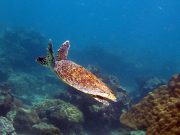
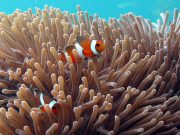
The coral formations provide shelter for numerous invertebrates, including sea urchins, sea stars, and anemones, which are often seen hosting playful clownfish.
Find out more from the Thailand Department of National Parks on the Mu Koh Phi Phi Marine National Park.
Coral Reef
Phi Phi's Viking Bay area contains a very diverse mix of hard and soft corals, including dense hard coral bommies, branching and table corals, soft corals, anemones, sea fans, bubble corals, fire corals and whip corals.
Just to the north of Viking Bay is Table Coral City which was originally home to many huge table corals in the shallow areas, however sadly the 2004 Indian Ocean Tsunami destroyed most of these delicate structures. This area is now known simply as Coral City.
Coral Restoration Projects
An extensive on-going coral restoration project is restoring large numbers of acropora branching and table corals to the area, and these efforts are clearly visible during dives here.
Fish Species
A huge variety of fish species are spotted along the part of Phi Phi Leh, including snapper, fusiliers, sweetlips, clownfish, scorpionfish and lionfish, wrasse, damselfish, grouper, parrotfish, sweepers, and coral breams.
Schools of juvenile and adult longfin batfish can be seen sheltering around Artificial Reef, along with schools of larger hunting snapper, barracuda, and trevallies.
Porcupinefish and pufferfish are also seen hanging around just outside the giant cube structures.
Macro life
Both Viking Bay and Artificial Reef are home to large numbers of nudibranchs, wart slugs and lots of other macro life such as porcelain anemone crabs, cleaner shrimp, and peacock mantis shrimp.
Other Marine Life
Moray eels and banded sea snakes can also be found here, along with sea cucumbers, sea urchins and sea stars.
As air-breathing reptiles, sea snakes normally live on land, where they find warm sunshine, fresh water, and somewhere to sleep. Sea snakes normally only spend about 30% of their time underwater hunting for food.
It’s also not uncommon to spot a critically endangered hawksbill turtle on a dive around this part of Phi Phi. These gentle creatures are frequently spotted grazing on the reef or swimming gracefully through the water.
If you’re super lucky, you might also spot a leopard shark resting on the sand in the deeper areas outside Viking Bay.
Exploring Phi Phi Viking Bay & Artificial Reef
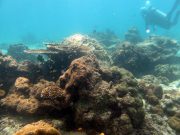
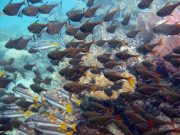
Viking Bay
The reef at Viking Bay slopes from the shallows down to around 30m, however most of the action is in the 5m - 15m range.
Viking Bay is particularly known for its encounters with turtles, which are frequently seen grazing on bubble coral formations scattered around the reef.
Schools of snapper, sweeper and fusiliers are often found at Viking Bay, along with cuttlefish, moray eels, pipefish, pufferfish, grouper, butterfly and angel fish, scorpion fish, box fish and trumpet fish.
Large schools of crocodile needlefish patrol the shallows, with schools of giant trevallies, cobia, and large snapper regularly hunting on the reef and cruising past the divers.
Artificial Reef
Directly opposite Viking Bay lie the pyramids of Artificial Reef in slightly deeper water. Created as part of a larger effort to restore damaged coral reefs and enhance marine biodiversity around the Phi Phi islands, the Artificial Reef has become a thriving underwater ecosystem in its own right.

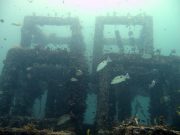
Construction began in 2006 with an initial 100 concrete cubes provided by the Department for Marine and Coastal Resources as a response to the degradation of natural reefs due to the Indian Ocean Tsunami of 2004, overfishing, climate change, and tourism pressures.
The artificial reef has since been expanded several times by the addition of hundreds more concrete cubes, and now also includes the addition of substantial acropora branching and table coral nurseries.
The man-made pyramids range in depth from 7m to 17m and are located in a part of Phi Phi Leh which is almost untouched by currents, even during new and full moon periods.
Conservation Success Story
Artificial Reef is now home to a huge number of thriving hard and soft corals, anemones, gorgonian sea fans and thousands of reef fish, Artificial Reef is a resounding conservation success story.
With dozens of new staghorn and branching corals taking root, schools of snapper, moorish idols, bannerfish, porcupinefish, wrasse, damselfish, scorpion fish, goat fish and many more species now seek shelter in among the huge concrete blocks, this artificial reef project is a fantastic success.
Table Coral City
Just to the north of Viking Bay and Artificial Reef lies Table Coral City, or Coral City as it’s now known.
Between Artificial Reef and Coral City, you’ll find a fairly vast sandy area, with scattered corals and anemones. Here we can find shrimp gobies working tirelessly to excavate the burrows they share with their partner gobiefishes.
Keep a keen eye on the sand for leopard flounders, blue spotted stingrays and cuttlefish which may be difficult to spot.
About halfway to Coral City, divers will find an extensive soft coral garden between 8 and 12 metres, home to coral breams, grouper, moray eels and a huge variety of other species. Hawksbill Turtles are frequent visitors to this huge soft coral area.
Phi Phi's Coral City is a relatively shallow dive site, with large areas of both hard and soft corals starting in the shallows and sloping to around 12 - 15 metres.
The reef area is usually bathed in sunlight, with large schools of snapper and fusiliers found along the reef, hunting the huge numbers of tiny glassfish found sheltering close to the coral bommies and sea fans.
Koh Phi Phi - Viking Bay Dive Site Guide
- NameViking Bay & Artificial Reef
- Visibility5m - 15m +
- Level of DivingAll Levels
- SnorkelingLimited
- Depth3m - 20m +
- CurrentsMild to Medium
- Journey Time35 - 40 mins

Book online to save 10% on dive trips and scuba courses on Koh Lanta.
Koh Phi Phi Diving Price
Koh Lanta Dive Trips
Fun Diving price at Koh Phi Phi is ฿3,150 for 2 dives. Diving price includes dive guide, free equipment rental, lunch & soft drinks on the boat when booked online in advance.
- 2 Dives
- FREE Equipment Rental
- Dive Guide
- Lunch & Soft Drinks
- 2 Dives
- FREE Equipment Rental
- Dive Guide
- Lunch & Soft Drinks
- You must be certified minimum SSI/PADI Open Water Diver, CMAS 1 Star Diver, BSAC Ocean Diver, or equivalent.
- Does not include Marine Park Diving Fee: Thai ฿240, Foreigner ฿600, per day.
See a complete list of all our Koh Lanta Diving Prices.
Book online to save 10% on dive trips and scuba courses on Koh Lanta.
Coral Reef Conservation
Protecting marine life at Koh Phi Phi
Koh Phi Phi is part of the Hat Noppharat Thara-Mu Ko Phi Phi National Park, a marine protected area. This status helps preserve the underwater ecosystem at Koh Phi Phi, and ensures sustainable tourism practices.
Divers visiting Koh Phi Phi are encouraged to follow guidelines that minimise their impact on the environment
Responsible Diving Practices
To protect the delicate marine environment, divers are urged to follow responsible diving practices, including:
- Avoid touching or disturbing marine life while diving at Koh Phi Phi: Many marine organisms are delicate and can be harmed by human contact.
- Practice good buoyancy control while diving at Koh Phi Phi: Maintaining proper buoyancy helps prevent accidental damage to corals and other marine life.
- Do not collect souvenirs from Koh Phi Phi: Removing shells, corals, or other marine life from the sea is illegal and harmful to the ecosystem.
- Dispose of waste properly: Do not throw any rubbish or food into the sea, especially at the dive site. Throwing food into the water at a coral reef interferes with the delicate marine eco-system.
- Use Reef Safe Sun Block: Ensure your sunscreen is Reef Safe and does not harm the corals and marine life at Koh Phi Phi.
Koh Lanta Dive Sites
Some of Thailand's Best Diving
Koh Phi Phi is one of the best dive sites in Thailand, and can be easily dived from Koh Lanta by speedboat along with many of Thailand's other top dive sites:
- Lanta Marine Park
- Koh Haa Islands
- Koh Rok Islands
- Hin Daeng & Hin Muang
- Hin Musang Wildlife Reserve
- Shark Point & Anemone Reef
- Phi Phi Marine Park
- Bida Nok & Bida Nai
- Hin Bida
- Koh Phi Phi
- HTMS Kledkaeo Wreck
- Hin Klai
Find out more at the Thai Department of National Parks.
Our Dive Trip Schedule
Lanta Dive trips from mid Oct - mid May
Our dive trips depart Koh Lanta in the morning every day during high season from the south end of Long Beach, normally returning around 1:30 - 2pm.
| Week Day | Boat 1 | Boat 2 |
| Monday | Koh Bida / Phi Phi | Koh Bida / Phi Phi |
| Tuesday | Koh Haa Islands | Hin Daeng & Hin Muang |
| Wednesday | Koh Bida / Phi Phi | Koh Bida / Phi Phi |
| Thursday | Koh Haa Islands | Koh Haa Islands |
| Friday | Koh Haa Islands | Hin Daeng & Hin Muang |
| Saturday | Koh Bida / Phi Phi | Koh Bida / Phi Phi |
| Sunday | Koh Haa Islands | Koh Haa Islands |
- All trips are 2 dives a day
- Trips depart from the beach at our dive shop @ Lanta Castaway Beach Resort
- Trips Depart 8/9am, return 2pm
- Dive & Relax is open from mid Oct - mid May.
- E-mail us info@diveandrelax.com in advance with any questions, or to make a booking.
We may schedule a Shark Point & Anemone Reef dive trip or a KledKaeo Wreck & Hin Klai dive trip upon request. A minimum of 5 divers are required for these trips, please let us know if you are interested.
We love to dive as much as possible during the high season, however all our dive trips depend on the weather, sea conditions, currents and minimum numbers and may be subject to change at short notice.
For more information on our weather and climate, check out the best time to visit Koh Lanta.
Book online to save 10% on dive trips and scuba courses on Koh Lanta.

